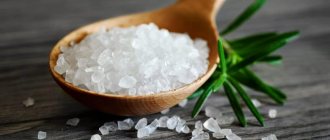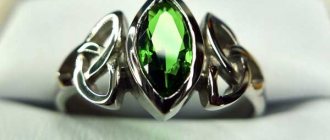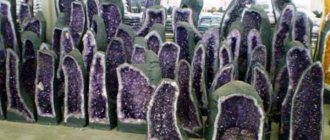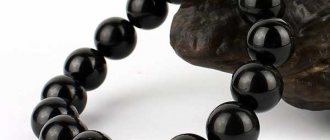Being in nature
The silicon content in the earth's crust is, according to various sources, 27.6-29.5% by mass.
Thus, in terms of abundance in the earth’s crust, silicon ranks second after oxygen. Concentration in sea water is 3 mg/l. Most often in nature, silicon is found in the form of silica - compounds based on silicon dioxide (IV) SiO2 (about 12% of the mass of the earth's crust). The main minerals and rocks formed by silicon dioxide are sand (river and quartz), quartz and quartzites, flint, and feldspars. The second most common group of silicon compounds in nature are silicates and aluminosilicates.
Isolated cases of finding pure silicon in native form have been noted.
Forms of being in nature
Moissanite single crystal (~1 mm in size)
Natural silicon carbide - moissanite can be found only in negligible quantities in some types of meteorites and in corundum and kimberlite deposits. Almost any silicon carbide sold in the world, including in the form of moissanite jewelry, is synthetic. Natural moissanite was first discovered in 1893 as small hexagonal plate-like inclusions in the Canyon Diablo meteorite in Arizona by Ferdinand Henri Moissan, after whom the mineral was named in 1905.[9] Moissan's research on the natural origin of silicon carbide was initially controversial because his sample may have been contaminated with silicon carbide chips from a saw (saws at the time already contained the substance)[10].
Although silicon carbide is a rare substance on Earth, it is widespread in space. This substance is found in dust clouds around carbon-rich stars, and it is also abundant in pristine, unaltered meteorites (almost exclusively in the form of the beta polymorph). Analysis of silicon carbide grains found in the carbonaceous chondrite Murchison meteorite showed an anomalous isotopic ratio of carbon and silicon, which indicates the origin of this substance outside the solar system: 99% of SiC grains formed near carbon-rich stars belonging to the asymptotic giant branch [11]. Silicon carbide can often be detected around such stars from their spectra[12].
Modernity
At the end of the 20th century, the first crystal of carborundum was made; before that it was known only in powder form. As soon as it became possible to synthesize a crystal, it was synthesized. The result was amazing. In many respects, carborundum was superior to diamond.
- the degree of light refraction is a quarter higher;
- the variance is two and a half.
That is, it shines better and gives more rainbow highlights. It would seem that this is luck. It was indeed recognized as the best imitation diamond. But it never became widespread. From a commercial point of view, making jewelry with carboride makes no sense.
The production of stone jewelry is too complex and expensive. A large sample will cost about $500 per carat. It is doubtful that there will be people who like to buy artificial stones for that kind of money. Even if they are high-tech and super shiny. Currently, only one American company makes silicon carbide crystals, and it is less common on sale than diamonds.
Theoretically, the stone should be beautiful: shiny, shining, with a rainbow play of light on the edges.
But connoisseurs of the stone do not really value it. There are several reasons for this:
- bright shimmers of light are unusual for the eye and rather irritate, creating the impression of tastelessness and arrogance;
- There are no transparent or pure-colored stones. They all have a dusty greenish tint. Chemists can't do anything about it yet;
- The rays of light that the diamond casts are dense, bright, and with rich shades. Carborundum gives more transparent and dark reflections.
As we see, artificial moissanite failed to surpass diamond and displace it from jewelry counters.
Opaque inexpensive samples are sold by enterprising Italians as pieces of lava from Vesuvius.
However, carborundum has a number of advantages:
- it does not leave fatty marks on itself. If you touch a diamond for a long time, it will become covered with a fatty film and stop sparkling. Carborundum is immune to this. No matter how much you touch it, it will continue to shine;
- Since carborundum is grown artificially, it is free from defects. It is cut into ideal, mathematically precisely verified crystals. In addition, you don’t have to save on material. This doesn't always work with diamonds. Sometimes he wants to preserve the weight of the stone and deliberately violates the proportions, sometimes he avoids defects. This is not considered a marriage. Such diamonds, although their prices are lower, are still available on the market;
- in extreme temperatures (about 1000 degrees Celsius), diamond burns, but carborundum does not. You can throw a platinum ring into a coal furnace and it won't be harmed.
In addition, it is durable and only slightly inferior to diamond. In addition, it is inert - it does not react with other substances (except for hydrofluoric, nitric and orthophosphoric acids), has high thermal conductivity, electric current density and electrical voltage, has a low coefficient of thermal expansion and does not have phase transitions that destroy the crystal.
Carborundum is now produced by the thermal decomposition of polymethylsilane at low temperatures in the presence of an inert gas. The resulting material is used in many areas of life.
Used as:
- abrasive for grinding and spraying for saws;
- raw materials for cutting tools;
- semiconductor in the electrical industry;
- catalyst in the chemical industry;
- bearings and equipment elements in smelting furnaces, since it can withstand loads of up to 1700 degrees Celsius;
- raw materials for the production of body armor;
- basis for high-power LEDs;
- raw materials for the manufacture of high-quality disc brakes;
- raw materials for creating mirror parts in optical systems.
That's not all. The stone is used in nuclear energy, construction, and organic synthesis.
Structure and properties
There are approximately 250 known crystalline forms of silicon carbide. SiC polymorphism is characterized by a large number of similar crystal structures, called polytypes. They are variations of the same chemical compound that are identical in two dimensions but different in the third. Thus, they can be considered as layers stacked in a certain sequence.
Alpha silicon carbide (α-SiC) is the most commonly found polymorph. This modification is formed at temperatures above 1700 °C and has a hexagonal lattice and a wurtzite-type crystal structure.
What is carborundum made from?
The main problem when creating diamonds is the length and complexity of the process. Under natural conditions, stone is formed over thousands of years under colossal pressure from 45,000 to 60,000 atmospheres and at temperatures over 900 degrees, so it is almost impossible to repeat the entire process exactly as natural.
The first documentary description of an attempt to synthesize diamonds dates back to 1823, when our compatriot Vasily Karazin obtained unknown crystals as a result of experiments with heating and distillation of dry wood.
However, it is officially believed that the first stone with properties most similar to diamonds was discovered by French researcher and Nobel laureate Henri Moissan
However, it is officially believed that the first stone with properties most similar to diamonds was discovered by French researcher and Nobel laureate Henri Moissan. In 1905, the silicon carbide crystal he obtained, in honor of its creator, began to be called moissanite. Silicon carbide occurs naturally and is often called stardust due to its cosmic origin, but its natural size is very small and has a specific color.
Without giving up the desire to create perfect diamonds in the laboratory, scientists have learned to synthesize larger and purer stones. Artificially grown moissanite is often called carbocorundum.
Russian and Soviet scientists made a great contribution to the creation of artificial diamonds. The bulk of synthetic stones are produced using technologies developed by them. Today, moissanite is obtained in several ways, but the purest and highest quality crystals of carbocorundum are born by heating crystalline silicon carbide at a temperature of 2,400 ºC for many hours with the participation of a metal catalyst (iron).
Artificial diamonds with a coarse-grained structure have been produced on an industrial scale since the middle of the last century.
In addition to the thermobaric method described above, their creation uses a method of deposition of crystals from a plasma of gaseous carbon under the influence of an electric arc and a rare detonation technology that uses the energy of a blast wave.
To grow diamonds in laboratory conditions, substances with a high concentration of carbon are used: purified soot or coal, graphite, etc. Depending on how such diamonds were obtained, there is a division into HPHT and CVD diamonds.
Today, the only manufacturer on the silicon carbide market in Russia is Volzhsky Abrasive Plant OJSC, founded in 1961. It is also considered the largest manufacturer of silicon carbide in Europe and the largest manufacturer of ceramic bonded abrasive tools in Russia and the CIS. Due to the rarity of moissanite in nature, silicon carbide is usually of artificial origin. The main components of silicon carbide are quartz sand and coke. The key factors that determined the location of the Volzhsky plant were proximity to the Volzhskaya hydroelectric station and the presence of a nearby deposit of quartz raw materials. Today, the Volzhsky Abrasive Plant grows silicon carbide crystals of two types: green and black. Volzhsky silicon carbide is in demand primarily for its excellent quality, which allows it to compete with one of the world's main producers of silicon carbide - China.
Biological role
For some organisms, silicon is an important biogenic element. It is part of the supporting structures in plants and skeletal structures in animals. Silicon is concentrated in large quantities by marine organisms - diatoms, radiolarians, sponges. Large amounts of silicon are concentrated in horsetails and cereals, primarily in the subfamilies of Bamboo and Rice, including rice.
It is also used to build the cell walls of some organisms and is the center of reactivity for the dozen or so enzymes responsible for "processing" diatomaceous silica in some crustaceans.
Silicon is found in many plants that are essential for proper development, but it has not been shown to be necessary for the development of all species. Typically, its presence increases resistance to pests, especially fungi, and prevents their penetration into plant tissues saturated with silica. Similarly, in the case of animals, the need for silicon has been demonstrated for the six-rayed sponges, but although this occurs in the bodies of all animals, it is not generally found to be necessary for them. In vertebrates, this occurs in large quantities in hair and feathers (for example, sheep's wool contains 0.02-0.08% SiO2). Human muscle tissue contains (1-2)⋅10−2% silicon, bone tissue - 17⋅10−4%, blood - 3.9 mg/l. Up to 1 g of silicon enters the human body with food every day.
In the human body
Silicon has been proven to be important for human health, particularly for nails, hair, bones and skin. Research shows that premenopausal women with higher intakes of bioavailable silicon have higher bone density, and that silicon supplementation may increase bone volume and density in patients with osteoporosis
The human body needs 20-30 mg of silicon per day. Pregnant women, people after bone surgery and the elderly require a higher dose, as the amount of this element in the organs decreases with age. This occurs mainly in the connective tissue that makes up tendons, mucous membranes, blood vessel walls, heart valves, skin and the osteoarticular system. Silicon removes toxic substances from cells, preferentially acts on capillaries, seals them, increases the strength of bone tissue, strengthens the body's defenses against infections, and prevents premature aging. Relieves irritation and inflammation of the skin, improving its overall appearance and preventing dullness, reduces hair loss, accelerates its growth, strengthens nails. Since silicon is involved in bone formation by ensuring the elasticity of blood vessels involved in the absorption of calcium from the diet and the growth of hair and nails, its deficiency in the human body can cause bone abnormalities, general growth retardation, infertility, lack of development and osteoporosis. Silicon dioxide under normal conditions is always a solid, bioinert, non-degradable substance, prone to the formation of dust, consisting of particles with sharp cutting edges. The harmful effect of silicon dioxide and most silicides and silicates is based on the irritating and fibrogenic effect, on the accumulation of the substance in the lung tissue, causing a serious disease - silicosis. Dust respirators are used to protect the respiratory system from dust particles. However, even with the use of personal protective equipment, the nasopharynx and throat of people who systematically work in dusty conditions with silicon compounds and especially silicon monoxide show signs of inflammatory processes on the mucous membranes. The standards for maximum permissible concentrations of silicon are tied to the content of silicon dioxide dust in the air. This is due to the peculiarities of silicon chemistry:
- Pure silicon, as well as silicon carbide, in contact with water or atmospheric oxygen forms an impenetrable film of silicon dioxide (SiO2) on the surface, which passivates the surface;
- Many organosilicon compounds in contact with atmospheric oxygen and water vapor are oxidized or hydrolyzed, ultimately forming silicon dioxide;
- Silicon monoxide (SiO) in air is capable (sometimes with an explosion) of oxidizing to highly dispersed silicon dioxide.
Application of material
The main areas of application of silicon carbide are electronics and energy. This substance is used in the production of semiconductor mechanisms, LEDs, resistors, transistors and energy meters. These devices are highly durable and can function stably for 10 years. They are used in high-frequency electronics. Silicon carbide products have the following properties:
- They have a large band gap;
- Can operate at high temperatures (up to 600 °C);
- They have increased thermal conductivity, unlike devices made of gallium arsenide and other minerals.
- Resistant to radiation and electrical charges.
Due to the high fire resistance and heat resistance of the material, it is actively used in metallurgy and the chemical industry. Many heating devices are made from carborundum solid solution and are capable of operating at high temperatures (up to 2000 °C). These devices can function in neutral or reduced environments. Heating elements are actively used in the heat treatment of metal parts for ceramic devices and electronic components.
Silicon carbide is used as an abrasive due to the high strength and low cost of the chemical compound. In abrasive machining, this material is used in the following processes:
- grinding;
- lamination of paper products;
- sandblasting;
- honing;
- water jet cutting.
Carborundum has found wide application in the production of structural materials. It is resistant to physical stress and is widely used in the manufacture of bulletproof vests and disc brakes installed on vehicles. Since the 1990s Carborundum is used to make durable gas turbines. They are resistant to high temperatures and shock loads.
Silicon carbide
| Price: from 209.40 rubles with VAT per kg |
Minimum quantity: 100 kg
Silicon carbide - properties and application Silicon carbide SiC (or carborundum) is a refractory, chemically resistant, solid substance with semiconductor properties. The chemical compound contains approximately 70% silicon Si and about 30% carbon C. In its pure form, carborundum is colorless; the presence of impurities determines the color and type of conductivity of the crystals: p-type (beryllium, gallium, boron) or n-type (phosphorus, nitrogen ). Silicon carbide is rarely found in nature (moissanite), so it is mainly of artificial origin. It is obtained by sintering silica with carbon in electric melting furnaces with carbon electrodes at temperatures of about 1500-2400 degrees. The crystal lattice is atomic. With a low density (3.2 g/cm^3), silicon carbide has exceptional hardness. In this it is second only to diamond and borazone (boron carbide). Melting point more than 2830 degrees. Carborundum is resistant to oxidation, mineral acids, and inert in nitrogen, carbon dioxide and hydrogen. It is highly resistant to radiation environments. Silicon carbide is widely used in electrical engineering. Semiconductor devices made on its basis are capable of maintaining stable and reliable operation at temperatures up to 600 degrees. This becomes possible due to the large value of the band gap (on average 2.39 eV). It is also used for the manufacture of radiation LEDs, solar cells, heaters, thermistors, lightning arresters and electrical insulating devices. In the metallurgical and steel industries, due to its properties such as thermal resistance and high chemical stability, carborundum is used as a refractory material. Using fibers from this material, temperatures up to 2500K can be measured. The hardness and wear resistance of silicon carbide, as well as its low cost, are used in the production of grinding materials. High cutting capacity is suitable for processing materials such as glass, ceramics, rubber, cast iron, stone, titanium and various polymers. Its high thermal conductivity makes it an excellent material for creating bearings. In weapons protection it is used as composite armor for military equipment and bulletproof vests. In appearance, moissanite is similar to diamond and is used in jewelry as a diamond substitute. Wheels made of carborundum-based composite material are used on sports cars. Silicon carbide has also found its place in astronomical optics. The future of silicon carbide is quite optimistic. The low cost of the material, its unique electrophysical characteristics and the development of nanotechnology open up broad prospects for its use.
Preparation of silicon carbide
The largest amount of naturally occurring silicon carbide is found in outer space: in dust clouds surrounding stars and in meteorites. On Earth, this material is present only in deposits of kimberlite or corundum, which complicates the process of its extraction on an industrial scale. For this reason, carborundum used in modern industrial and domestic environments is artificial.
The most common method of producing this chemical compound is by heating silica with carbon in specialized ovens powered by electricity. The substance is heated to a temperature of 1800-2300 °C. Sources of silicon are quartz sand, purified from impurities, and anthracite. To improve the gas permeability of the material, sawdust is used. The color of synthetic carborundum is changed by adding sodium chloride (table salt). The density of the material is increased by pressing. After these processes, the structural particles change their location, which leads to deformation of the solid solution.
This substance is also obtained using the following methods:
- Sublimation. This technology provides the cultivation of silicon carbide grains of natural materials. Crystal growth is carried out in graphite crucibles from the gas phase. Carborundum can be obtained using this technology from inert gases heated to a temperature of 2600 °C.
- Epitaxy. This method is used to obtain solid solutions of silicon carbide. It uses hydrogen, previously purified from impurities using diffusion methods. The chemical element reacts with free carbon, resulting in the formation of semiconductor films.
- Synthesis. The raw material for producing carborundum is graphite, crushed to a powder state. Also, to obtain the required material, you can use carbon black with a particle size of no more than 20 microns. The synthesis of chemical substances occurs in the solid phase, which is due to the large distance between the carbon and silicon atoms.
- Batch preparation. This method requires components containing large amounts of carbon and silicon. Nanopowders, carbohydrates or polyhydric alcohols can be used as raw materials. The mixture is prepared in deionized water for 5.5 hours. The material is heated stepwise to a temperature of 1650 °C.
For industrial needs, carbides of green and black colors are most often produced. The features of their chemical composition are defined in GOST 26327-84. It specifies 4 grades of silicon carbide: 53C, 54C, 63C and 64C.
Silicon carbide black
Black silicon carbide is a particularly durable abrasive material, which is obtained by artificially combining carbon and silicon. Melting occurs in a graphite electric furnace at temperatures above 1600 degrees. The result is a powder with properties that allow it to be used in many industries. You can buy this abrasive at a low price from us, at the Litpromabraziv company. We offer black silicon carbide, which has a certificate of conformity with GOST of Ukraine.
The scope of application of silicon carbide is more than just wide. He found his place in the manufacturing industry. Its hardness allows you to grind all possible surfaces of brittle, hard, viscous materials, wood, non-ferrous metals, brick, glass and so on. Due to its characteristic density, it is ideal for sandblasting and waterjet cutting. Silicon carbide is also used to produce sandpaper. The abrasive density is 3.21 g/cm3, hardness is 33 GPa.
The Litpromabraziv company offers fast delivery of silicon carbide to all regions of the Russian Federation by road and railway transport. Unloading directly at the enterprise is also possible.
| Grinding grain | |||||||||||||||||||
| Brand | Grit size GOST | FEPA Grit | Chemical composition | Grain composition | Magnetic material | Bulk density g/cm3 | Destructibility %, no more | ||||||||||||
| SiC (not less) | Fe (no more) | C (no more) | 1 | Residue on sieve | 2 | Residue on sieve | 3 | Residue on sieve | 3,4 | Residue on sieve | 3,4,5 | Residue on sieve | |||||||
| 54C | 160 | F12 | 97,5 | 0,2 | 0,4 | 2,8 | 0 | 2 | 20% | 1,7 | 45% | 1,4 | 70% | 1,18 | — | — | — | — | |
| 54C | — | F14 | 97,5 | 0,2 | 0,4 | 2,36 | 0 | 1,7 | 20% | 1,4 | 45% | 1,18 | 70% | 1 | — | — | 1,31 | 75 | |
| 54C | 125 | F16 | 97,5 | 0,2 | 0,4 | 2 | 0 | 1,4 | 20% | 1,18 | 45% | 1 | 70% | 0,85 | — | — | 1,35 | 75 | |
| 54C | 100 | F20 | 97,5 | 0,2 | 0,4 | 1,7 | 0 | 1,18 | 20% | 1 | 45% | 0,85 | 70% | 0,71 | — | — | 1,35 | 75 | |
| 54C | — | F22 | 97,5 | 0,2 | 0,4 | 1,4 | 0 | 1 | 20% | 0,85 | 45% | 0,71 | 70% | 0,6 | — | — | 1,37 | 75 | |
| 54C | 80 | F24 | 97,5 | 0,2 | 0,4 | 1,18 | 0 | 0,85 | 25% | 0,71 | 45% | 0,6 | 65% | 0,5 | — | — | 1,37 | 75 | |
| 54C | 63 | F30 | 98 | 0,2 | 0,3 | 1 | 0 | 0,71 | 25% | 0,6 | 45% | 0,5 | 65% | 0,425 | — | — | 1,4 | 75 | |
| 54C | 50 | F36 | 98 | 0,2 | 0,3 | 0,85 | 0 | 0,6 | 25% | 0,5 | 45% | 0,425 | 65% | 0,355 | — | — | 1,4 | 47 | |
| 54C | — | F40 | 98 | 0,2 | 0,3 | 0,71 | 0 | 0,5 | 30% | 0,425 | 40% | 0,355 | 65% | 0,3 | — | — | 1,4 | 47 | |
| 54C | 40 | F46 | 98 | 0,2 | 0,3 | 0,6 | 0 | 0,425 | 30% | 0,355 | 40% | 0,3 | 65% | 0,25 | — | — | 1,4 | 47 | |
| 54C | 32 | F54 | 98 | 0,2 | 0,3 | 0,5 | 0 | 0,355 | 30% | 0,3 | 40% | 0,25 | 65% | 0,212 | — | — | 1,4 | 47 | |
| Sanding powders | |||||||||||||||||||
| Brand | Grit size GOST | FEPA Grit | Chemical composition | Grain composition | Magnetic material | Bulk density g/cm3 | Destructibility %, no more | ||||||||||||
| SiC (not less) | Fe (no more) | C (no more) | 1 | Residue on sieve | 2 | Residue on sieve | 3 | Residue on sieve | 3,4 | Residue on sieve | 3,4,5 | Residue on sieve | |||||||
| 54C | 25 | F60 | 97,5 | 0,2 | 0,4 | 0,425 | 0 | 0,3 | 30% | 0,25 | 40% | 0,212 | 65% | 0,18 | — | — | 1,4 | 47 | |
| 54C | 20 | F70 | 97,5 | 0,2 | 0,4 | 0,355 | 0 | 0,25 | 25% | 0,212 | 40% | 0,18 | 65% | 0,15 | — | — | 1,35 | 47 | |
| 54C | — | F80 | 97,5 | 0,2 | 0,4 | 0,3 | 0 | 0,212 | 25% | 0,18 | 40% | 0,15 | 65% | 0,125 | — | — | 1,35 | 47 | |
| 54C | 16 | F90 | 97 | 0,3 | 0,5 | 0,25 | 0 | 0,18 | 20% | 0,15 | 40% | 0,125 | 65% | 0,106 | — | — | 1,33 | 0,08 | |
| 54C | 12 | F100 | 97 | 0,3 | 0,5 | 0,212 | 0 | 0,15 | 20% | 0,125 | 40% | 0,106 | 65% | 0,075 | — | — | 1,33 | 0,08 | |
| 54C | 10 | F120 | 97 | 0,3 | 0,5 | 0,18 | 0 | 0,125 | 20% | 0,106 | 40% | 0,09 | 65% | 0,063 | — | — | 1,27 | 0,08 | |
| 54C | 8 | F150 | 97 | 0,3 | 0,5 | 0,15 | 0 | 0,106 | 15% | 0,075 | 40% | 0,063 | 65% | 0,045 | — | — | 1,27 | 0,08 | |
| 54C | 6 | F180 | 96 | 0,6 | 0,4 | 0,125 | 0 | 0,09 | 15% | 0,075 | — | 0,063 | 40% | 0,053 | 0,65 | — | 1,27 | 0,07 | |
| 54C | 5 | F220 | 97 | 0,3 | 0,4 | 0,106 | 0 | 0,075 | 15% | 0,063 | — | 0,053 | 40% | 0,045 | 0,6 | — | 1,27 | 0,07 | |
| Micro grinding powders | |||||||||||||||
| Brand | Grit size GOST | FEPA Grit | Chemical composition | Grain composition | Magnetic material | Bulk density g/cm3 | Cutting ability | ||||||||
| SiC (not less) | Fe (no more) | C (no more) | Grain size at the 3% point of the distribution curve Ds3 no more, µm | Grain size at the 50% point of the distribution curve Ds50 no more, µm | Grain size at the 94% point of the distribution curve Ds94 no more, microns | ||||||||||
| 54C | M50 | F240 | 98 | 0,3 | 0,4 | Ds3 | 70 | Ds50 | 44,5±2,0 | Ds94 | 28 | — | — | 0,068 | |
| 54C | — | F280 | 98 | 0,3 | 0,4 | Ds3 | 59 | Ds50 | 36,5±1,5 | Ds94 | 22 | — | — | 0,062 | |
| 53C | M40 | F320 | 97 | 0,3 | 0,4 | Ds3 | 49 | Ds50 | 29,2±1,5 | Ds94 | 16,5 | — | — | 0,055 | |
| 53C | M28 | F400 | 97 | 0,3 | 0,4 | Ds3 | 32 | Ds50 | 17,3±1,0 | Ds94 | 8 | — | — | 0,04 | |
| 53C | M20 | F500 | 97 | 0,3 | 0,4 | Ds3 | 25 | Ds50 | 12,8±1,0 | Ds94 | 5 | — | — | 0,037 | |
| 53C | M14 | F600 | 97 | 0,3 | 0,4 | Ds3 | 19 | Ds50 | 9,3±1,0 | Ds94 | 3 | — | — | 0,02 | |
| 53C | M10 | F800 | 96 | 0,4 | 0,5 | Ds3 | 14 | Ds50 | 6,5±1,0 | Ds94 | 2 | — | — | 0,015 | |
| 53C | M7 | F1000 | 97 | 0,5 | 0,4 | Ds3 | 10 | Ds50 | 4,5±0,8 | Ds94 | 1 | — | — | 0,014 | |
Moissanite (carborundum)
The latest attempt to create a high-quality synthetic diamond imitation turned out to be moissanites.
When talking about moissanite, it is very important to understand the difference between the natural mineral formation and its synthetic counterpart of the same name
The mineral moissanite is a natural mineral, named after its discoverer, Henri Moissanite (1852-1907), Nobel laureate in chemistry (1906). Natural moissanite is not suitable for cutting into gemstones due to its very small (maximum 2-3mm) grain size, dark opaque light and extreme rarity. Moissanite is a silicon carbide, SiC, with a hexagonal crystal structure (as opposed to the cubic structure of diamond)
Moissanite was synthesized even before (1893) it was discovered (1905) in nature.
In 1987, a method for synthesizing colorless moissanite was found in the Cree Research laboratory (USA). True, until 1993, these stones were not completely colorless, to be more precise - they were at best near colorless and corresponded to a color no higher (in the best examples) IJ on the GIA scale for diamonds. In 1998, the technology for synthesizing truly colorless moissanite by sublimation was patented, and since then these stones have the registered trade name “Charles & Colvard created Moissanite”
Since the introduction of CZ (cubic zirconia in the Russian version) to the market in 1976, moissanite has proven to be the best known diamond simulant. However, a trained eye can easily distinguish moissanite from “a girl’s best friend.”
Due to its different crystalline structure from diamond, moissonite has very strong birefringence, which is in principle impossible for diamond (diamond)
Due to its different crystalline structure from diamond, moissonite has very strong birefringence, which is in principle impossible for diamond. If you look “through” the moissanite at an angle to its upper platform, then the bifurcation of the pavilion’s edges will ALWAYS be clearly visible. That is, the edges will look like in a “blurry, out-of-focus photograph.”
A reliable identifier of moissanite is its relative density (3.22 versus 3.52 for a diamond). In methylene iodide, a denser diamond will sink, while a less dense moissanite will “float”.
The “spot test” will not help due to the very high refractive index of moissanite - it will not show the difference between moissonite and a diamond, but it will show the difference from natural or synthetic zircon.
A reliable way to guarantee the identification of moissanites is to heat them to temperatures above 230 degrees. At this temperature, all moissanites without exception turn greenish-yellow or brown, which disappears immediately after cooling.
Scope of application
Charcoal is used in industry for the following purposes:
- for use as part of filters;
- for melting crystalline silicon;
- for use in metallurgy (saturation of steel with carbon, production of pure alloys);
- for the production of glass, some types of plastics, paints;
- for the production of natural dye for the food industry;
- for the production of activated carbon;
- for use in agriculture;
- for use as a convenient household fuel for stoves, fireplaces, barbecues.
When burned in stoves and fireplaces, this type of fuel burns with virtually no flames, providing even and intense heat. The most highly valued product is grade A, which is made from hardwood.
Properties and description of carborundum stone
Carborundum, or moissanite, is a stone that belongs to the class of semiconductor binary chemical compound. This is silicon carbide, obtained under artificial conditions within 30-40 hours. The stone is obtained by melting coal and sand. Characterized by the pronounced shine that anthracite has. If the stone falls under the direct rays of the sun, it shimmers with all the colors of the rainbow. Thanks to its high hardness rating (9.1 on the Mohs scale), carborundum can scratch any mineral except diamond.
This is a refractory gem, characterized by resistance to acids and other aggressive factors. Does not melt at temperatures above 1500 degrees Celsius. It also has the property of refracting light. There are more than 250 crystalline forms of carborundum, which determine the color range. The stone does not collapse under intense and prolonged friction.
The formula and technology for producing carborundum was patented by Edward Goodrich Acheson in 1893. However, in 1842, a similar combination of chemical elements was obtained by the scientist Despretz.
A natural analogue is extremely rare. To this day, large deposits of carborundum have not been found.
Applications of silicon carbide
It would seem, what do artificial diamonds, winter tires, disc brakes, solar panels, body armor and abrasive wheels have in common? It turns out that despite the strangeness of this series of objects, there is something in common between them: all of these products use the same chemical compound. We are talking about silicon carbide (technical name: carborundum). Silicon carbide is a binary inorganic chemical compound of silicon and carbon (SiC). A crystal of pure silicon carbide is colorless with a diamond luster, refractory, second only to diamond and boron nitride in hardness, and chemically resistant. It occurs in nature in the form of an extremely rare mineral - moissanite. Silicon carbide powder was first produced artificially in 1893. In turn, thanks to the unique combination of physicochemical properties of silicon carbide, it is widely in demand in a huge number of areas that can be listed ad infinitum. For example, adding silicon carbide to tires increases wear resistance and improves traction, and the unique thermal stability of this compound makes it suitable for making bearings and equipment parts for high-temperature furnaces. It is also used in such areas as mechanical engineering, nuclear energy, at enterprises of the defense, metallurgical, food, chemical, oil production and oil refining industries.
Another important industry that uses silicon carbide is power electronics - this is an important part of the electrical power industry as a whole. In the last decade, significant progress has been made both in the technology of semiconductor silicon carbide and in the technology of devices based on it. There is a rapid modernization of the technology for growing single crystals, increasing their sizes and improving their parameters. The unique properties of this compound arouse interest in silicon carbide from developers of electronics components in a number of leading countries in the world.
Application of SiC[edit]
Carborundum
technical name for silicon carbide used for technical purposes as an abrasive. It is also used for the manufacture of parts for chemical and metallurgical equipment operating at high temperatures. The color of carborundum can vary from colorless to green or black.
Silicon carbide is a promising semiconductor material. It is a wide-gap semiconductor (gap width Eg=2.2÷3.2 eV, depending on modification).
The conductivity type of silicon carbide depends on the impurities. Conductivity n
-type is obtained by doping with nitrogen or phosphorus, and
p
-type conductivity is obtained with the help of aluminum, boron, gallium or beryllium.
The electrical conductivity of the resulting material greatly depends on the type and amount of impurity.
The use of silicon carbide is promising in power and microwave electronics due to high operating temperatures, electrical strength and good thermal conductivity. The wide bandgap opens up the possibility of using silicon carbide as a material for the manufacture of highly efficient LEDs covering the entire visible range of the spectrum. The use of silicon carbide as a semiconductor material is currently just beginning due to the difficulty of obtaining high-quality single crystals.
Silicon carbide is used as a component of composite armor used to protect weapons and military equipment, and also as a component of ceramic/organoplastic layered armor in the production of body armor. The Dragon Skin vest, created by Pinnacle Armor, uses silicon carbide discs.
Silicon carbide is used to make artificial gemstones for jewelry. As a gemstone, silicon carbide is called “synthetic moissanite” or simply “moissanite”. Moissanite is similar to diamond: it is transparent and hard (9-9.5 on the Mohs scale, compared to 10 for diamond), with a refractive index of 2.65-2.69 (compared to 2.42 for diamond).
Application area
| The style of this section is non-encyclopedic or violates the norms of the Russian language. The section should be corrected according to Wikipedia's stylistic rules. |
Friction pairs in the mechanical seal units of pumping units are used for pumping petroleum products and liquefied gas. Chemically resistant pumps for operation in aggressive environments were created and equipped with parts (impeller, shaft, friction pairs) made of silicon carbide. Friction pairs made of silicon carbide, instead of impregnated belting supports in the axial support units of submersible pumps
Silicon carbide is also used for the manufacture of nozzles and nozzles for supplying gases to the zone of melting glass and metals, and sintering ceramics.
- Nozzles of various sizes made of silicon carbide: for sandblasting installations;
- for high-temperature sandblasting units (sand temperature about 1000 °C), used for cleaning pipes from carbon deposits at oil production and oil refining enterprises;
silicon carbide crucibles,
- In jewelry (synthetic crystals up to 10 carats);
- For the manufacture of armor plates, for various protective systems;
- It is considered a promising material for the semiconductor industry: Used for the production of lasers;
- Used in the production of high-power LEDs (up to 9 watts);
- Experiments are actively underway using the material in microelectronics;
Isotopes and their applications
Main article: Isotopes of silicon
Silicon consists of stable isotopes 28Si (92.23%), 29Si (4.67%) and 30Si (3.10%). The remaining isotopes are radioactive.
The 29Si nucleus (like the proton) has a nuclear spin of I = 1/2 and is increasingly used in NMR spectroscopy. 31Si, formed by the action of neutrons on 30Si, has a half-life of 2.62 hours. It can be determined by characteristic β-radiation, and it is very convenient for the quantitative determination of silicon by neutron activation analysis. The radioactive nuclide 32Si has the longest half-life (~170 years) and is a soft (low-energy) β-emitter.
Receipt
Free silicon is obtained by calcining fine white sand (silicon dioxide) with magnesium:
SiO2+2Mg → 2MgO+Si{\displaystyle {\mathsf {SiO_{2}+2Mg\ \rightarrow \ 2MgO+Si}}}
In this case, amorphous silicon
, having the appearance of a brown powder.
In industry, silicon of technical purity is obtained by reducing the SiO2 melt with coke at a temperature of about 1800 °C in shaft-type ore-thermal furnaces. The purity of silicon obtained in this way can reach 99.9% (the main impurities are carbon and metals).
Further purification of silicon from impurities is possible.
- Purification in laboratory conditions can be carried out by first obtaining magnesium silicide Mg2Si. Next, gaseous monosilane SiH4 is obtained from magnesium silicide using hydrochloric or acetic acids. Monosilane is purified by rectification, sorption and other methods, and then decomposed into silicon and hydrogen at a temperature of about 1000 °C.
- Silicon purification on an industrial scale is carried out by direct chlorination of silicon. In this case, compounds of the composition SiCl4, SiHCl3 and SiH2Cl2 are formed. They are purified from impurities in various ways (usually by distillation and disproportionation) and at the final stage they are reduced with pure hydrogen at temperatures from 900 to 1100 °C.
- Cheaper, cleaner and more efficient industrial technologies for silicon purification are being developed. As of 2010, these include silicon purification technologies using fluorine (instead of chlorine); technologies involving distillation of silicon monoxide; technologies based on etching of impurities concentrated at intercrystalline boundaries.
The impurity content in post-purified silicon can be reduced to 10−8–10−6% by weight. The issues of obtaining ultra-pure silicon are discussed in more detail in the article Polycrystalline silicon.
A method for obtaining silicon in its pure form was developed by Nikolai Nikolaevich Beketov.
In Russia, technical silicon is produced by OK Rusal at plants in Kamensk-Uralsky (Sverdlovsk region) and Shelekhov (Irkutsk region); Silicon, further purified using chloride technology, is produced by the Nitol Solar group at a plant in Usolye-Sibirskoye.
Thermal conductivity of silicon carbide foam of different densities
The table shows the values of the thermal conductivity coefficient (in W/(m deg)) of silicon carbide foam of various densities in an argon atmosphere and in a vacuum (up to 10-3 mm Hg). The thermal conductivity of silicon carbide foam is indicated at temperatures from 1200 to 2000 K for densities of 1280, 1050, 880 and 550 kg/m3.
According to the table, it can be seen that as the density of silicon carbide foam decreases, its thermal conductivity decreases . The thermal conductivity of this pore-filled carbide foam in an argon atmosphere (with a pressure of up to 2 atmospheres) is generally greater than in a vacuum. However, denser carbide foam tends to be significantly thermally conductive in a vacuum than in an argon gas atmosphere.
It should be noted that as the temperature of silicon carbide foam increases, its thermal conductivity decreases.
Source: Chirkin V.S. Thermophysical properties of nuclear technology materials. M.: Atomizdat, 1967. - 474 p.
Short description
Silicon (IV) oxide SiO2 is a solid, refractory crystalline substance that does not dissolve in water and does not react with it. The chemical component exhibits oxidizing properties. At temperatures above +1000°C, SiO2 interacts with active metals. In this case, silicon is formed:
- SiO2 + 2Mg = Si + 2MgO.
- 3SiO2 + 4Al = 3Si + 2Al2O3.
With an excess of silicon, silicides are reduced. This chemical reaction has the following formula: SiO2 + 4Mg = Mg2Si + 2MgO. Silicon reacts with hydrogen, and when carbon is used, carborundum is formed: SiO2 + 3C = SiC + 2CO.
If you try to fuse silicon oxide with alkalis, you will eventually get silicates:
- SiO2 + 2NaOH = Na2SiOO3 + H2O.
- SiO2 + CaO = CaSiO3.
- SiO2 + K2CO3 = K2SiO3 + CO2.
- SiO2 + H2O ≠.
At normal air pressure and temperature, three crystalline modifications of SiO2 can be distinguished: tridymite, quartz and cristobalite. In each case, high-temperature and low-temperature forms are known. They are based on SiO4 tetrahedra, which are connected by four oxygen atoms in a three-dimensional lattice.
Properties of monoxide
In chemistry lessons you can learn that the formula of silicon oxide is as follows - SiO2. Externally, this substance has a viscous consistency, more like resin. Without any impact, silicon oxide perfectly retains its condensed state and is not subject to oxidation. SiO2 does not affect the formation of salts and also does not allow current to pass through. Silicon monoxide can be obtained by two available methods:
- Heat the silicon to +400°C or higher if there is insufficient oxygen. The formula is as follows: 2Si + O2 → 2SiO.
- Using a special Czochralski method (growing single crystals by pulling them upward from the free surface of a large volume of melt) during the reduction of dioxide under high temperature conditions. Formula: 2SiO2 + Si → 2SiO.
In the solid state, the monoxide is a brown powder. This chemical has high strength and inertness when interacting with acids. Complete dissolution of the monoxide can only be achieved in hydrofluoric acid. Among the main chemical properties of SiO2 are:
- Monoxide can only decompose when exposed to high temperatures. This reaction can be represented using the following formula: 2SiO → 2Si + O2.
- When heated, the monoxide reacts with CO2. Formula: SiO + CO2 → SiO2 + CO.
- Silicon monoxide reacts with H2O vapor, but only when heated to +500°C. This process is clearly visible in the formula: SiO + H2O → SiO2 + H2.
- Liquid silicon chloride can be obtained by additionally using chlorine and heating the mixture to +800°C. Visually, this reaction looks like this: 2SiO + 4Cl2 → 2SiCl4 + O2.
Characteristics of dioxide
Silicon oxide (SiO2) is a crystalline, refractory substance that is insoluble in water. This chemical component does not conduct electricity. In chemistry lessons in the 8th grade, students are explained that dioxide is part of the following rocks:
- Sand.
- Rock crystal.
- Jasper.
- Quartz.
- Agatha.
- Amethyst.
The lithosphere is 87% dioxide. This chemical substance has a non-molecular structure. The oxygen and silicon atoms are bonded covalently. Thanks to this, a crystal lattice was formed. Dioxide can be obtained in laboratory conditions. To do this, silicon together with oxygen is heated to +500°C: Si + O2 → SiO2.
When soluble silicates are exposed to acids, dioxide is formed. As a result, silicic acid is formed, which breaks down into dioxide and water. The chemical reaction looks like this:
- Na2 SiO3 + 2CH3COOH → 2CH3COONa + H2SiO3↓.
- H 2SiO3 → H2O + SiO2.
Under normal conditions, dioxide reacts only with hydrofluoric acid. But it can interact with basic oxides and alkalis only when exposed to high temperatures. Dioxide does not react to H2O. Today, this chemical is used to mass-produce silica gel, glass and concrete.











